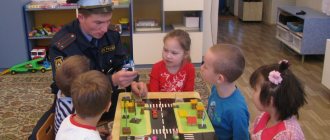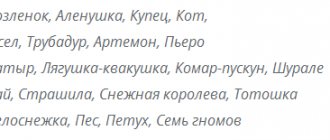A series of conversations for parents about family education. “Family is the basis of a child’s spiritual health.”
The authority of love is the most common. In order for children to obey, they need to love their parents, and to earn this love, you need to show your children your parental love at every step. Such a family plunges into a sea of sentimentality and no longer notices anything else. A child should do everything out of love for his parents. This is where family egoism grows. Very soon, children begin to understand that dad or mom can be deceived in any way they want, as long as they see the tender expression on their face. This is a dangerous kind of authority. He raises insincere, deceitful egoists. And often the parents themselves become victims. These families most often produce cynics, prudent businessmen, cruel and aggressive people.
The authority of kindness is the most stupid type of authority. Parents allow everything, they don’t regret anything, they are generous, they are wonderful parents. For the sake of peace in the family, they are ready to sacrifice anything. Very soon the children will be in charge in this family. And it happens that the desires and demands of children receive such scope that it may already be too late to show any resistance. Children's obedience is acquired by parental kindness, gentleness, compliance, and unscrupulousness. Parents are afraid of conflicts and avoid them, sacrificing themselves. Children in such a family are capricious, demanding, and command their parents.
The authority of friendship - in general, of course, this is a good look, as long as it does not go to extremes. In this case, the rule must always be remembered - no friendship is possible without mutual respect. It must be remembered that parents remain senior members of the family team, and children remain pupils.
The authority of bribery is the most immoral, since obedience is bought with gifts and promises. Children cannot be rewarded for obedience or good attitude towards their parents. Some kind of encouragement is possible in the family, for example, for good studies, for doing some difficult work. The highest praise should be verbal encouragement like “you did the right thing.” There is no need to spur children on in their school or other work with tempting promises. In such conditions, children, based on personal gain, maneuver and adapt.
Modern types of families
(conversation for parents)
The family is part of the social system. Society, influencing the family, forms a certain type of family.
Russian psychologists distinguish several types of families:
The patriarchal or traditional family is the most archaic form of family relationships. It relies on the dependence of the wife on her husband and the children on their parents. In such a family, absolute parental power and an authoritarian system of education dominate. Most often, in these families, children grow up with a predominance of low self-esteem. Such families include the families of modern rich people who believe that the degree of their wealth automatically determines the level of intellectual capabilities and moral qualities of their children. They demand submission not only at work, but also at home.
File of conversations in the senior group
Among the verbal methods of interaction with children of the senior and middle groups (5–6 years old) of preschool educational institutions, conversation, as a form (question-answer) for discussing a certain topic, occupies a special place.
For your information! For preschoolers of this age group, conversation is a basic form of communication, which is designed to enrich the experience of life, develop curiosity and make a person more sociable.
Conversation with preschool children
In the work of a kindergarten teacher, an obligatory item is the compilation of card files of conversations of various topics and types. A conversation with older children, a thematic conversation helps to understand how to behave in a given situation, react correctly and not make a mistake. Cognitive, useful information will benefit not only educators, but also mothers.
Conversation about professions in the senior group
The teacher should try to form realistic ideas about a person’s everyday work life.
It is important to enrich the knowledge of preschoolers and their ideas about different professions (firefighter, space specialist, and so on). Thanks to classes and conversations in the group, the vocabulary is enriched and coherent speech is formed.
On a note! This type of conversation forms the ability to coherently and consistently convey a text read or heard according to a drawn-up plan. It has a positive effect on the development of attention and memory of preschool children, and develops logic.
Conversation “Rules of behavior in public places”
The conversation “Rules of Conduct in a Public Place” is required to be included in the file cabinet. The purpose of the conversation is to develop the students’ ability to behave in accordance with moral standards and etiquette rules developed and implemented by the children themselves in the process of working in a group on class topics.
Teacher talking to children
The teacher must convey information and discuss with children the rules of behavior in public places. This helps develop the communication skills of preschoolers.
Conversation about healthy lifestyle in the senior group
A conversation on healthy lifestyle in the preparatory group and a file cabinet with the goals of the Federal State Educational Standard are being developed. Necessary for consolidating the action plan when washing and knowledge about the purpose of hygiene items. The program should also develop in the child a desire to be clean and tidy, eat right and play sports.
For your information! A conversation about health teaches dialogue and kindness in communicating with each other and with adults.
Conversation about health in the senior group
The lesson includes two programs. The first is called “The skeleton is our support.” During the morning lesson, the teacher should introduce preschool children to the structure of the skeleton. Explain why it is needed for the human body, talk about the mechanisms of muscle tissue and its functionality.
It is important to expand students’ knowledge of how to strengthen muscle and bone tissue. Use illustrations as visual material, teach students to recognize and be able to talk about the human skeleton.
Healthy lifestyle for students
The teacher must arouse in pupils an interest in the body, a conscious attitude towards the body. For lessons, you should prepare a model of a human skeleton or a picture.
Second program: “Posture - slender back.” It is aimed at familiarizing children with the concept of “posture” and its importance for the body and human health. The teacher talks about posture problems and introduces children to knowledge of how to maintain correct posture. The teacher should teach children to recognize and be able to talk about the structure of the skeleton, correct and crooked posture from pictures.
For your information! It is important to interest the child so that he takes care of his health from an early age. For the lesson you will need pictures depicting a skeleton, a person with a curved spine, and with healthy posture.
Conversation about winter in the senior group
The purpose of the lesson is to systematize the understanding of pupils of the middle and senior groups of preschool educational institutions about winter phenomena in winter. It is important to learn to find connections between:
- the life of animals and birds (how they winter);
- states of nature;
- air temperature;
- state of water and land.
On a note! During the lesson, the teacher teaches how to see and give an aesthetic assessment of natural beauty in May or another season. Forms a poetic perception of nature. Every new year, the teacher takes a new month (January, February, and so on). Lessons about the seasons will help develop memory, thinking, imagination, and will also teach you to take care of the nature of your native land.
Drawing on the theme “Mimosa” in the middle groups of kindergarten
Conversation with migratory birds
When spring comes, the teacher of the senior group must draw up a work plan in accordance with the Federal State Educational Standard. Provide conditions for deepening students’ knowledge about:
- weather;
- thaw;
- plants;
- migratory birds.
Studying birds in preschool educational institutions
Thanks to this, preschool children will learn more about the work of people in spring, get acquainted with paintings by famous artists about spring, and make their own crafts from paper, plasticine, and natural materials. At the end of the week, the teacher conducts a “Why and Why” quiz. Asks questions and listens to children’s answers, thereby consolidating the students’ knowledge.
On a note! The teacher can not only talk with children, but also play. It is useful to organize a variety of relay races in a group and on the street. The teacher, involving pupils in outdoor activities, solves the problems of physical development.
Conversation about indoor plants in the senior group
The kindergarten teacher talks to the children in the group, tells them what kind of indoor plants there are, shows pictures or visual examples on the windows in the room. Teaches you to recognize and correctly name types of flowers.
In addition, he shows how to care for some types of plants (watering, lighting, pruning, fertilizing) and improves the students’ skills in caring for indoor plants. The child learns to be thrifty with plants. The materials you will need for this lesson are:
- Pictures of indoor plants.
- Maintenance equipment - skewers for loosening, watering cans, rags, aprons.
- Filmstrips, audio films.
The teacher is working with the children in a group where there are pots of flowers.







